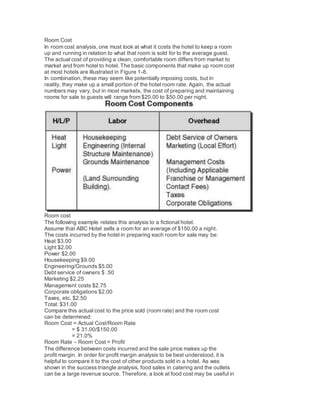Room cost
- 1. Room Cost In room cost analysis, one must look at what it costs the hotel to keep a room up and running in relation to what that room is sold for to the average guest. The actual cost of providing a clean, comfortable room differs from market to market and from hotel to hotel. The basic components that make up room cost at most hotels are illustrated in Figure 1-8. In combination, these may seem like potentially imposing costs, but in reality, they make up a small portion of the hotel room rate. Again, the actual numbers may vary, but in most markets, the cost of preparing and maintaining rooms for sale to guests will range from $20.00 to $50.00 per night. Room cost The following example relates this analysis to a fictional hotel. Assume that ABC Hotel sells a room for an average of $150.00 a night. The costs incurred by the hotel in preparing each room for sale may be: Heat $3.00 Light $2.00 Power $2.00 Housekeeping $9.00 Engineering/Grounds $5.00 Debt service of owners $ .50 Marketing $2.25 Management costs $2.75 Corporate obligations $2.00 Taxes, etc. $2.50 Total: $31.00 Compare this actual cost to the price sold (room rate) and the room cost can be determined: Room Cost = Actual Cost/Room Rate = $ 31.00/$150.00 = 21.0% Room Rate – Room Cost = Profit The difference between costs incurred and the sale price makes up the profit margin. In order for profit margin analysis to be best understood, it is helpful to compare it to the cost of other products sold in a hotel. As was shown in the success triangle analysis, food sales in catering and the outlets can be a large revenue source. Therefore, a look at food cost may be useful in
- 2. comparison to room cost. A common misconception in the hospitality industry is to consider food sales as profitable as room sales. This is not the case, as the following review of food cost reveals.


